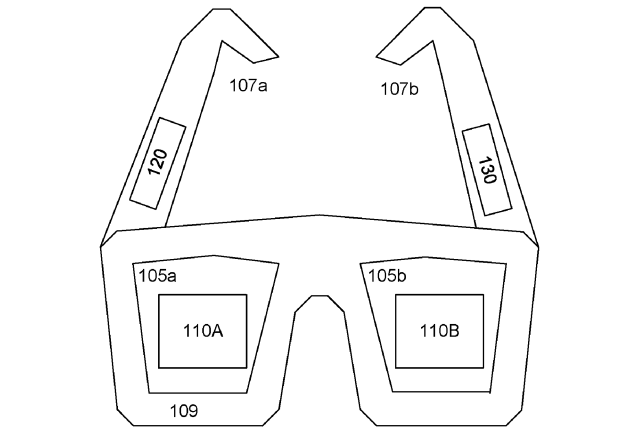Microsoft Patent | Optical Waveguide Using Overlapping Optical Elements
Patent: Optical Waveguide Using Overlapping Optical Elements
Publication Number: 20180348427
Publication Date: 2018-12-06
Applicants: Microsoft Technology Licensing, LLC

Abstract
An optical waveguide that performs both in-coupling and out-coupling using two diffractive optical elements is provided. Each optical element is a diffraction grating and can be applied to the same or different surface of the optical waveguide. The diffraction gratings overlap to form two overlapping regions. The first overlapping region in-couples light into the waveguide and the second overlapping region out-couples light from the optical waveguide. Because the optical waveguide only uses two gratings, and therefore only has two grating vectors, the optical waveguide is easier to manufacture than optical waveguides with a greater number of grating vectors.
BACKGROUND
Optical waveguides can be used to expand or replicate the exit pupil of an imaging system in one or two dimensions. Typically, light from the exit pupil of the imaging system is received in the waveguide through an in-coupling, and travels through the waveguide in a direction. The light then exits the waveguide through an out-coupling that is larger than the in-coupling, creating an expanded pupil.
Current waveguides typically use optical elements such as crossed gratings and double-sided gratings to in-couple and out-couple light. Crossed gratings are gratings that are periodic in two dimensions, while double-sided gratings are gratings that are located on both surfaces of the optical waveguide.
However, there are drawbacks associated with both cross and double-sided gratings. Crossed gratings are difficult to manufacture and typically do not have as many degrees of freedom (e.g., depth, slant, duty cycle, and fill factor) as double-sided gratings. Double-sided gratings have tight rotation tolerances and are therefore also difficult to manufacture.
SUMMARY
An optical waveguide that performs both in-coupling and out-coupling using two diffractive optical elements is provided. Each optical element is a diffraction grating and can be applied to the same or different surface of the optical waveguide. The diffraction gratings overlap to form two overlapping regions. The first overlapping region in-couples light into the waveguide and the second overlapping region out-couples light from the optical waveguide. Because the optical waveguide only uses two gratings, and therefore only has two grating vectors, the optical waveguide is easier to manufacture than optical waveguides with a greater number of grating vectors.
In an implementation, an optical waveguide is provided. The optical waveguide includes a front surface and a rear surface. The optical waveguide further includes a first optical element and a second optical element. The first optical element is disposed on the first surface or the second surface and defines a first region. The second optical element is disposed on the first surface or the second surface and defines a second region. The first optical element overlaps the second optical element to define a third region and a fourth region. The third region is configured to receive a beam of light, and in-couple the received beam of light into the optical waveguide. The first and second regions are configured to cause the received beam of light to traverse within the optical waveguide in a first direction. The fourth region is configured to out-couple the received beam of light from the optical waveguide in a second direction.
In an implementation, a head mounted display device is provided. The head mounted display device includes a projector; a controller coupled to the projector and configured to cause the projector to project a beam of light; and a plurality of optical waveguides. Each optical waveguide may include: a first surface; a second surface; a first optical element disposed on the first surface of the second surface and defining a first region; and a second optical element disposed on the first surface or the second surface and defining a second region. The first optical element overlaps the second optical element to define a third region and a fourth region. The third region is configured to: receive a beam of light; and in-couple the received beam of light into the optical waveguide. The first and second regions are configured to cause the received beam of light to traverse within the optical waveguide in a first direction. The fourth region is configured to out-couple the received beam of light from the optical waveguide in a second direction.
In an implementation, a method for operating an optical waveguide is provided. The method includes: providing a first optical element on a first surface of the optical waveguide, wherein the first optical element defines a first region; providing a second optical element on a second surface of the optical waveguide, wherein the second optical element defines a second region, and wherein the first optical element overlaps the second optical element to define a third region and a fourth region; receiving a beam of light by the third region; in-coupling the received beam of light into the optical waveguide by the third region; causing the received beam of light to traverse within the optical waveguide in a first direction by one or both of the first region and the second region; and out-coupling the received beam of light from the optical waveguide in a second direction by the fourth region.
This summary is provided to introduce a selection of concepts in a simplified form that are further described below in the detailed description. This summary is not intended to identify key features or essential features of the claimed subject matter, nor is it intended to be used to limit the scope of the claimed subject matter.




